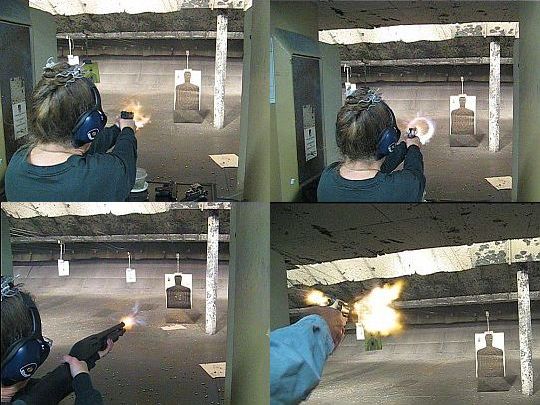
The images above show some of the muzzle blasts from Sunday’s trip to the range. Top left: Glock 26 9mm. Top right: Warthog .45ACP. Bottom left: Remington 870 12 gauge. Bottom right: S&W686 .38 special.
Here’s a reprise from a post I did last February on the visible component of muzzle flash:
- Muzzle glow – Muzzle glow is a reddish glow that is visible before the bullet leaves the barrel. Muzzle glow is created by superheated gases that have leaked past the projectile and have exited the barrel.
- Primary flashes – The primary flash is caused by propellant gases exiting the firearm behind the bullet. Although amongst the brightest of the flashes, the heat of the primary flash dissipates quickly and thus is no longer visible.
- Intermediate flashes – The intermediate flash is caused by shock waves created by the high speeds of the escaping gases and projectile, and appears as a reddish disc shape in front of the muzzle.
- Secondary flashes – Secondary flash appears farthest from the muzzle as a large white or yellow flame. Secondary flash is caused by the mixture of fuel-rich gases and oxygen in the atmosphere surrounding the muzzle.
- Sparks – Following the dissipation of the muzzle flash, partially unburnt powder or other heated materials can be ejected from the muzzle and appear as sparks.

Hey, that .38 special is wicked!
The big flame must have something to do with the short barrel. This gun has ‘great balls of fire’ coming out of it with either .38SPL or .357MAG rounds.
Now those are some outstanding photographs. I especially like the ring around the muzzle of Warthog – my Winchester SXZ ammunition does much the same thing.
That said, gorram, that .38 would make any goblin wet his pants.
I named my S&W686 the “Jerry Lee” because of the “great balls of fire.”
You have burning gases escaping from the muzzle (front) and forcing cone (sides) of the revolver. I went through the qualifying pistol course in the academy with an old Colt OP that shot lead out the front and sides (wad cutters). The rookie shooting out of the station on my left also had an old Colt that spit lead out in a 180 degree swath. Every now and then I would have to pick a little sliver of lead out of the back of my left hand from that station.